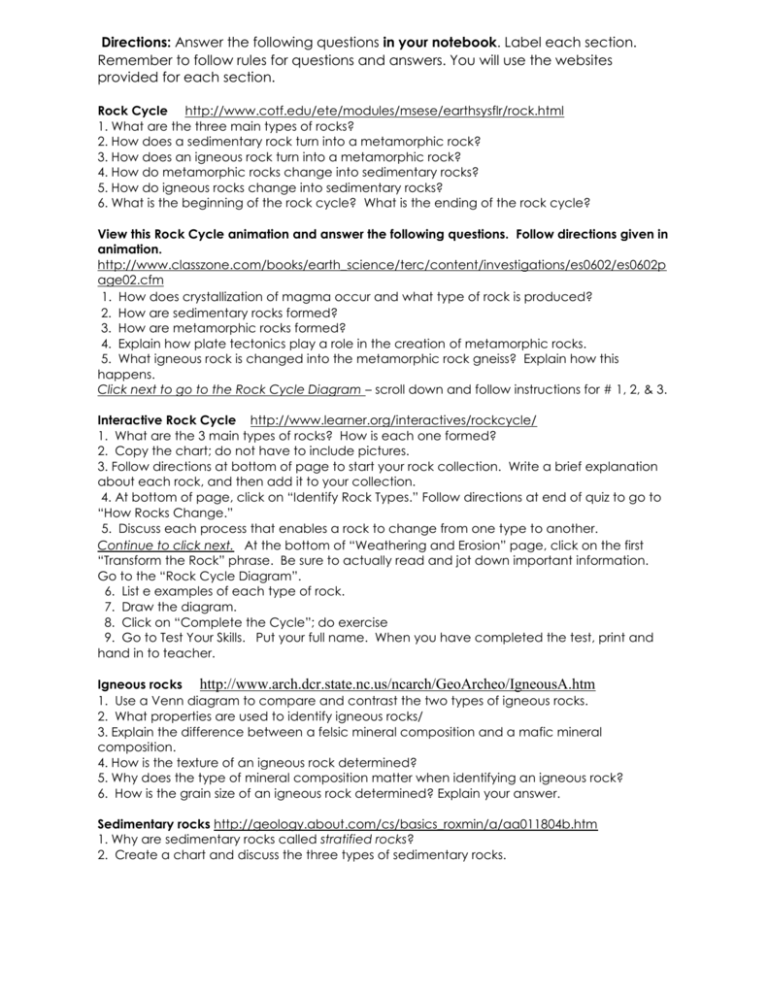Directions: Answer the following questions in your notebook
advertisement

Directions: Answer the following questions in your notebook. Label each section. Remember to follow rules for questions and answers. You will use the websites provided for each section. Rock Cycle http://www.cotf.edu/ete/modules/msese/earthsysflr/rock.html 1. What are the three main types of rocks? 2. How does a sedimentary rock turn into a metamorphic rock? 3. How does an igneous rock turn into a metamorphic rock? 4. How do metamorphic rocks change into sedimentary rocks? 5. How do igneous rocks change into sedimentary rocks? 6. What is the beginning of the rock cycle? What is the ending of the rock cycle? View this Rock Cycle animation and answer the following questions. Follow directions given in animation. http://www.classzone.com/books/earth_science/terc/content/investigations/es0602/es0602p age02.cfm 1. How does crystallization of magma occur and what type of rock is produced? 2. How are sedimentary rocks formed? 3. How are metamorphic rocks formed? 4. Explain how plate tectonics play a role in the creation of metamorphic rocks. 5. What igneous rock is changed into the metamorphic rock gneiss? Explain how this happens. Click next to go to the Rock Cycle Diagram – scroll down and follow instructions for # 1, 2, & 3. Interactive Rock Cycle http://www.learner.org/interactives/rockcycle/ 1. What are the 3 main types of rocks? How is each one formed? 2. Copy the chart; do not have to include pictures. 3. Follow directions at bottom of page to start your rock collection. Write a brief explanation about each rock, and then add it to your collection. 4. At bottom of page, click on “Identify Rock Types.” Follow directions at end of quiz to go to “How Rocks Change.” 5. Discuss each process that enables a rock to change from one type to another. Continue to click next. At the bottom of “Weathering and Erosion” page, click on the first “Transform the Rock” phrase. Be sure to actually read and jot down important information. Go to the “Rock Cycle Diagram”. 6. List e examples of each type of rock. 7. Draw the diagram. 8. Click on “Complete the Cycle”; do exercise 9. Go to Test Your Skills. Put your full name. When you have completed the test, print and hand in to teacher. Igneous rocks http://www.arch.dcr.state.nc.us/ncarch/GeoArcheo/IgneousA.htm 1. Use a Venn diagram to compare and contrast the two types of igneous rocks. 2. What properties are used to identify igneous rocks/ 3. Explain the difference between a felsic mineral composition and a mafic mineral composition. 4. How is the texture of an igneous rock determined? 5. Why does the type of mineral composition matter when identifying an igneous rock? 6. How is the grain size of an igneous rock determined? Explain your answer. Sedimentary rocks http://geology.about.com/cs/basics_roxmin/a/aa011804b.htm 1. Why are sedimentary rocks called stratified rocks? 2. Create a chart and discuss the three types of sedimentary rocks. Metamorphic rocks http://www.mineralogy4kids.org/?q=rock-cycle/metamorphic-rocks 1. What does the term, “metamorphic” mean? 2. Changes in temperature and pressure causes minerals to do what in a rock? 3. List the two types of textures for metamorphic rocks. Explain each one. How are they identified? 4. Give 3 examples of foliated metamorphic rocks and 2 examples of nonfoliated metamorphic rocks. Moh’s Scale http://www.allaboutgemstones.com/mohs_hardness_scale.html 11. What is Moh’s Scale used for? 12. What mineral is a 10 on Moh’s Scale? 13. Give an example of a mineral with a hardness of 7 (according to Moh’s Scale). Tell me about that mineral. 14. If a mineral can scratch a penny, what number is it on Moh’s Scale? GO TO EDMODO TO DO THIS INTERACTIVE AT HOME http://archive.fossweb.com/modules3-6/EarthMaterials/activities/mohsdrill.html Streak http://academic.brooklyn.cuny.edu/geology/grocha/mineral/streak.html 15. Sometimes the color and the streak of a mineral are very different. Which one of the examples shows the greatest difference? GO TO EDMODO TO DO THIS INTERACTIVE AT HOME http://academic.brooklyn.cuny.edu/geology/leveson/core/graphics/streak/streak_sim3a.html Density http://higheredbcs.wiley.com/legacy/college/skinner/0471152285/animations/animations/m od_2/simulation_density_min.html 1. Calculate the density of the minerals in Moh’s Hardness Scale. Show ALL work! Re-copy and complete the chart below. Density (g/cm ) D 3.3 19 21.5 3 Mass (grams) 324 237 M 430 Volume (cm ) 120 V 0.8 V 3 Rocks, Minerals, and Elements http://ratw.asu.edu/aboutrocks_whatarerocks.html 1. How are rocks, minerals and elements related. 2. Draw a picture showing this relationship Crystal Structure http://ratw.asu.edu/aboutrocks_whycrystalstructure.html 1. Why is crystal structure important? Give example








